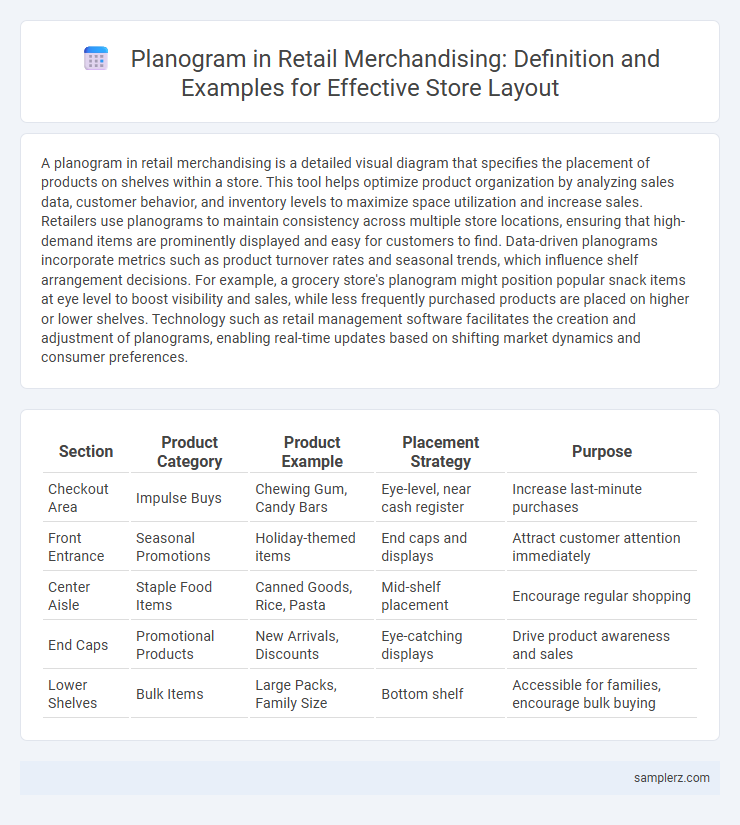A planogram in retail merchandising is a detailed visual diagram that specifies the placement of products on shelves within a store. This tool helps optimize product organization by analyzing sales data, customer behavior, and inventory levels to maximize space utilization and increase sales. Retailers use planograms to maintain consistency across multiple store locations, ensuring that high-demand items are prominently displayed and easy for customers to find. Data-driven planograms incorporate metrics such as product turnover rates and seasonal trends, which influence shelf arrangement decisions. For example, a grocery store's planogram might position popular snack items at eye level to boost visibility and sales, while less frequently purchased products are placed on higher or lower shelves. Technology such as retail management software facilitates the creation and adjustment of planograms, enabling real-time updates based on shifting market dynamics and consumer preferences.
Table of Comparison
| Section | Product Category | Product Example | Placement Strategy | Purpose |
|---|---|---|---|---|
| Checkout Area | Impulse Buys | Chewing Gum, Candy Bars | Eye-level, near cash register | Increase last-minute purchases |
| Front Entrance | Seasonal Promotions | Holiday-themed items | End caps and displays | Attract customer attention immediately |
| Center Aisle | Staple Food Items | Canned Goods, Rice, Pasta | Mid-shelf placement | Encourage regular shopping |
| End Caps | Promotional Products | New Arrivals, Discounts | Eye-catching displays | Drive product awareness and sales |
| Lower Shelves | Bulk Items | Large Packs, Family Size | Bottom shelf | Accessible for families, encourage bulk buying |
Introduction to Planograms in Retail Merchandising
Planograms serve as visual merchandising tools that strategically arrange products on retail shelves to maximize sales and enhance customer experience. By detailing product placement, shelf space allocation, and inventory levels, planograms ensure optimal product visibility and brand consistency. Retailers use planograms to drive efficient store layouts, increase product turnover, and support inventory management.
Benefits of Using Planograms in Store Layouts
Planograms optimize product placement by visually organizing merchandise based on consumer behavior and sales data, increasing shelf efficiency and maximizing space utilization. Retailers experience higher sales through strategic grouping of complementary items, enhancing customer navigation and purchase decisions. Consistent planogram implementation reduces stockouts and overstock situations, improving inventory management and overall store profitability.
Planogram Example: Grocery Store Shelf Arrangement
A planogram example in a grocery store shelf arrangement involves strategically placing products to maximize visibility and sales by categorizing items such as dairy, snacks, and beverages into distinct sections with eye-level positioning for high-demand brands. Essential factors include shelf space allocation based on sales data, product adjacency to encourage impulse buying, and maintaining consistent shelf height for easy restocking. Effective planograms increase customer convenience and optimize inventory turnover in retail merchandising.
Planogram Example: Fashion Apparel Display
A fashion apparel display planogram strategically arranges clothing items by color, size, and style to maximize visual appeal and encourage purchases. Mannequins showcase featured outfits near the entrance, while accessory pairings complement themed sections within the display. This layout enhances customer navigation and boosts sales by highlighting seasonal trends and coordinating apparel.
Planogram Example: Electronics Section Organization
The electronics section planogram arranges products by category, such as smartphones, laptops, and accessories, optimizing space and enhancing customer navigation. High-demand items like flagship smartphones are placed at eye level to maximize visibility and sales, while smaller accessories are grouped on adjacent shelves for easy cross-selling. Shelf tags and digital displays guide customer attention, increasing product engagement and streamlining the shopping experience.
Planogram Example: Beauty Products Merchandising
A beauty products merchandising planogram strategically arranges skincare, makeup, and fragrance items to maximize visibility and sales by grouping complementary products such as moisturizers next to serums and foundations near concealers. Prominent placement of high-demand brands like L'Oreal, Estee Lauder, and MAC at eye level encourages consumer engagement and increases the likelihood of purchase. Ensuring color coordination and clear labeling within the planogram enhances shelf appeal and streamlines the shopping experience in retail environments.
Planogram Example: Convenience Store Snack Placement
A convenience store snack placement planogram strategically arranges products by category, brand popularity, and customer purchase behavior to maximize shelf space and sales. High-demand snacks like chips and candy are placed at eye level, while complementary items such as nuts and granola bars occupy adjacent shelves to encourage impulse buys. Seasonal promotions and limited-time offers are highlighted at aisle ends to attract attention and boost overall revenue.
Planogram Example: Seasonal Product Displays
Seasonal product displays in retail planograms strategically position items such as holiday decorations, summer apparel, or winter accessories to maximize visibility and boost sales during specific times of the year. These planograms organize products by theme and color, enhancing customer engagement and facilitating quick decision-making. Effective seasonal displays often incorporate end caps and focal points to attract shoppers and drive higher conversion rates.
Best Practices for Implementing Planograms
Effective planogram implementation in retail merchandising involves analyzing customer flow and product sales data to optimize shelf space and product placement. Best practices include maintaining consistent planogram standards across all stores, using 3D digital tools for accurate product arrangement, and training staff on the importance of planogram compliance to enhance visual appeal and boost sales. Regular audits ensure adherence, enabling quick adjustments based on inventory changes and seasonal demand.
Measuring Planogram Effectiveness in Retail
Measuring planogram effectiveness in retail involves analyzing sales data, product placement, and customer traffic patterns to optimize shelf space and inventory turnover. Retailers utilize key performance indicators such as sales per square foot, planogram compliance rates, and product adjacency success to evaluate how well the visual merchandising drives consumer engagement and purchase behavior. Advanced analytics and store audits ensure continuous improvement and alignment with consumer preferences, enhancing overall retail performance.

example of planogram in merchandising Infographic
 samplerz.com
samplerz.com